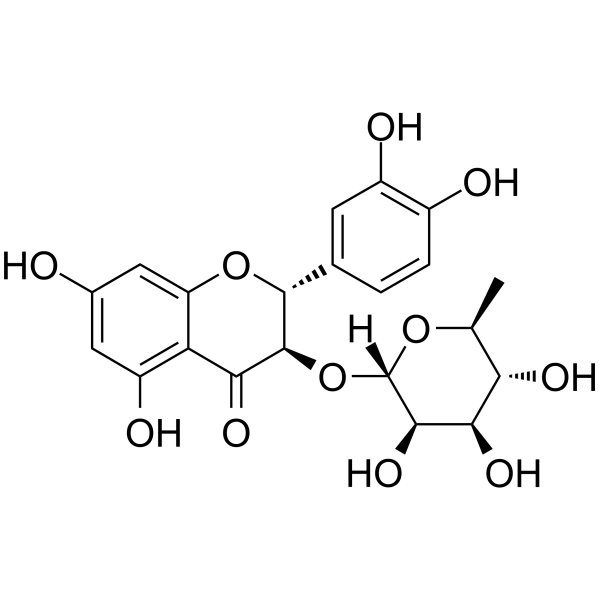上海金畔生物科技有限公司为生命科学和医药研发人员提供生物活性分子抑制剂、激动剂、特异性抑制剂、化合物库、重组蛋白,专注于信号通路和疾病研究领域。
Astilbin (Synonyms: 落新妇苷) 纯度: 99.22%
Astilbin 是一种黄酮类化合物,可增强 NRF2 活化。Astilbin 还抑制 TNF-α 表达和 NF-κB 活化。

Astilbin Chemical Structure
CAS No. : 29838-67-3
| 规格 | 价格 | 是否有货 | 数量 |
|---|---|---|---|
| 10 mM * 1 mL in DMSO | ¥880 | In-stock | |
| 10 mg | ¥800 | In-stock | |
| 25 mg | ¥1600 | In-stock | |
| 50 mg | ¥2600 | In-stock | |
| 100 mg | ¥3900 | In-stock | |
| 200 mg | 询价 | ||
| 500 mg | 询价 |
* Please select Quantity before adding items.
Astilbin 相关产品
•相关化合物库:
- Natural Product Library Plus
- Bioactive Compound Library Plus
- Apoptosis Compound Library
- Immunology/Inflammation Compound Library
- NF-κB Signaling Compound Library
- Stem Cell Signaling Compound Library
- Natural Product Library
- Anti-Cancer Compound Library
- Anti-Aging Compound Library
- Antioxidants Compound Library
- Differentiation Inducing Compound Library
- Glycoside Compound Library
- Oxygen Sensing Compound Library
- Ferroptosis Compound Library
- Phenols Library
- Pyroptosis Compound Library
- Traditional Chinese Medicine Monomer Library
- Flavonoids Library
- Anti-Breast Cancer Compound Library
- Anti-Pancreatic Cancer Compound Library
- Anti-Blood Cancer Compound Library
- Anti-Obesity Compound Library
- Angiogenesis Related Compound Library
- Transcription Factor Targeted Library
- Food-Sourced Compound Library
- Anti-Liver Cancer Compound Library
| 生物活性 |
Astilbin is a flavonoid compound and enhances NRF2 activation. Astilbin also suppresses TNF-α expression and NF-κB activation. |
||||||||||||||||
|---|---|---|---|---|---|---|---|---|---|---|---|---|---|---|---|---|---|
| IC50 & Target[1] |
|
||||||||||||||||
| 体外研究 (In Vitro) |
Astilbin is a common dietary flavonoid that can be found in various kinds of herbs and foods such as Smilax Glabra, Sarcandra glabra, grape and red wine. Astilbin markedly inhibits cisplatin-induced cell apoptosis and recovers cell growth. Astilbin significantly decreases reactive oxygen species (ROS) accumulation and alleviates ROS-induced activation of p53, MAPKs and AKT signaling cascades, which in turn attenuates cisplatin-induced HEK-293 cell apoptosis. Astilbin effectively enhances NRF2 activation and transcription of its targeting antioxidant genes to reduce ROS accumulation in cisplatin-induced HEK-293 cells. Astilbin obviously suppresses tumor necrosis factor alpha (TNF-α) expression and NF-κB activation, and also inhibits the expression of induced nitric oxide synthase (iNOS) and cyclooxygenase-2 (COX-2). To measure the effects of Astilbin on the growth of CDDP-treated renal cells, HEK-293 cells are treated with CDDP (100 μM) and/or Astilbin (200 μM). Astilbin treatment significantly improvescell growth in CDDP-induced HEK-293 cells[1]. 上海金畔生物科技有限公司 has not independently confirmed the accuracy of these methods. They are for reference only. |
||||||||||||||||
| 体内研究 (In Vivo) |
To explore whether Astilbin improves CDDP-induced nephrotoxicity in vivo, an acute cisplatin nephrotoxic mouse model is established. Single injection of CDDP with 8 mg/kg dose results in notable weight loss compared with control group. However, the phenomenon is significantly alleviated by Astilbin at dose of 50 mg/kg. The mice fed Astilbin alone do not show any obvious alteration in body weight. Similarly, serum creatinine (SCr) and blood urea nitrogen (BUN) are higher in CDDP-treated mice than in control group. Treatment with Astilbin also decreases SCr and BUN levels. To examine the protective effect of Astilbin on CDDP-induced renal histopathological damage, the mouse kidney sections are stained with H&E. The mice in control group and Astilbin treated group have normal kidney morphology, while kidneys in CDDP group show severe damage with tubular degeneration, necrosis and cystic dilatation of the tubules with focal hemorrhages. Administration of Astilbin mitigated kidney injury, resulting in lower histopathological score compared to CDDP group. The apoptosis of renal cells is also detected using TUNEL staining to determine whether Astilbin treatment decreased renal cell apoptosis in CDDP-induced acute nephrotoxic mice[1]. 上海金畔生物科技有限公司 has not independently confirmed the accuracy of these methods. They are for reference only. |
||||||||||||||||
| 分子量 |
450.39 |
||||||||||||||||
| Formula |
C21H22O11 |
||||||||||||||||
| CAS 号 |
29838-67-3 |
||||||||||||||||
| 中文名称 |
落新妇苷 |
||||||||||||||||
| 运输条件 |
Room temperature in continental US; may vary elsewhere. |
||||||||||||||||
| 储存方式 |
|
||||||||||||||||
| 溶解性数据 |
In Vitro:
DMSO : 100 mg/mL (222.03 mM; Need ultrasonic) H2O : < 0.1 mg/mL (ultrasonic;warming;heat to 60°C) (insoluble) 配制储备液
*
请根据产品在不同溶剂中的溶解度选择合适的溶剂配制储备液;一旦配成溶液,请分装保存,避免反复冻融造成的产品失效。 In Vivo:
请根据您的实验动物和给药方式选择适当的溶解方案。以下溶解方案都请先按照 In Vitro 方式配制澄清的储备液,再依次添加助溶剂: ——为保证实验结果的可靠性,澄清的储备液可以根据储存条件,适当保存;体内实验的工作液,建议您现用现配,当天使用; 以下溶剂前显示的百
|
||||||||||||||||
| 参考文献 |
|
| Cell Assay [1] |
HEK-293 cells are seeded into 96-well plate with a density of 5 × 104 cells/well and subsequently treated with CDDP, Astilbin (0, 10, 30, 50, 100, 200 and 300 μM) or CDDP+Astilbin for 24 h. After treatments, 20 μL of 5 mg/mL MTT is added to each well. The cells are incubated for additional 4 h at 37°C. Then cell supernatant is abandoned and 100 μL of formanzan is added to each well. The plate is shaken at room temperature for 15 min. Spectrophotometric absorbance is measured by Synergy Microplate Reader at 570 nm[1]. 上海金畔生物科技有限公司 has not independently confirmed the accuracy of these methods. They are for reference only. |
|---|---|
| Animal Administration [1] |
Mice[1] 上海金畔生物科技有限公司 has not independently confirmed the accuracy of these methods. They are for reference only. |
| 参考文献 |
|
所有产品仅用作科学研究或药证申报,我们不为任何个人用途提供产品和服务
